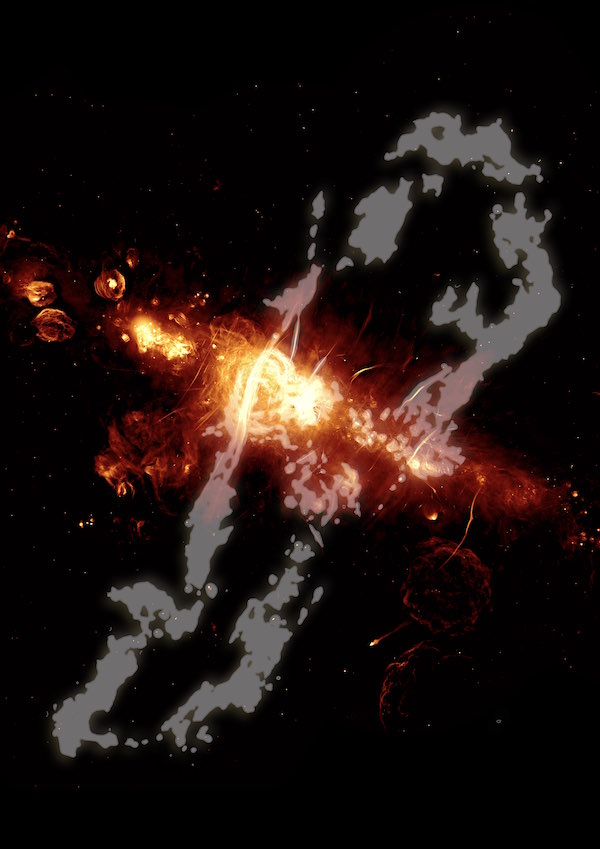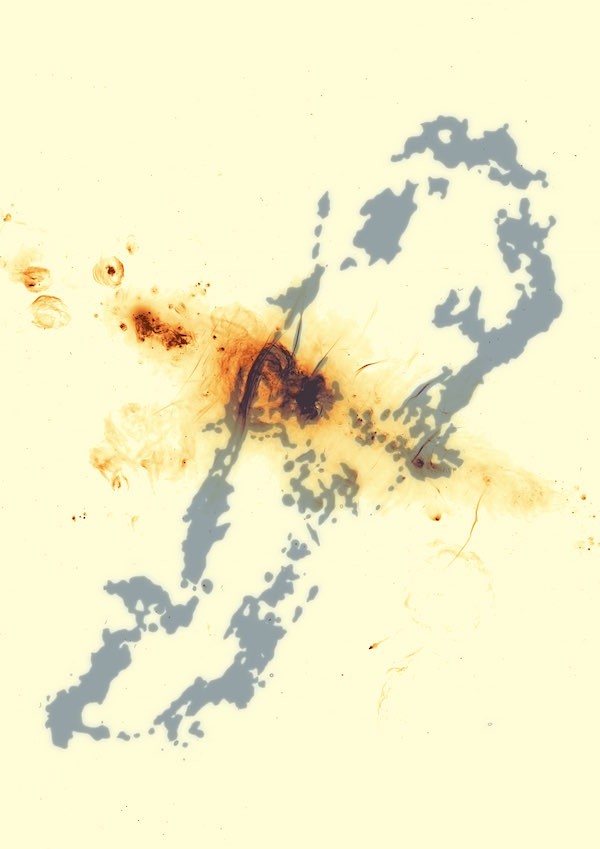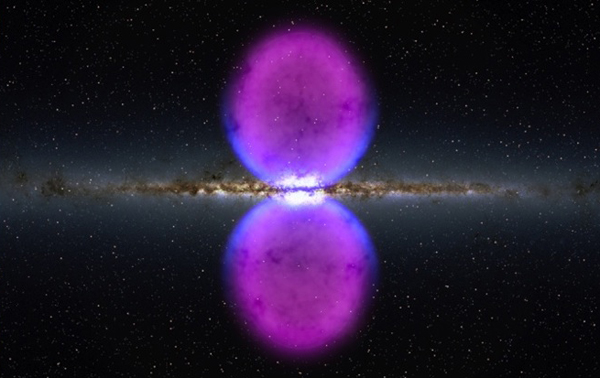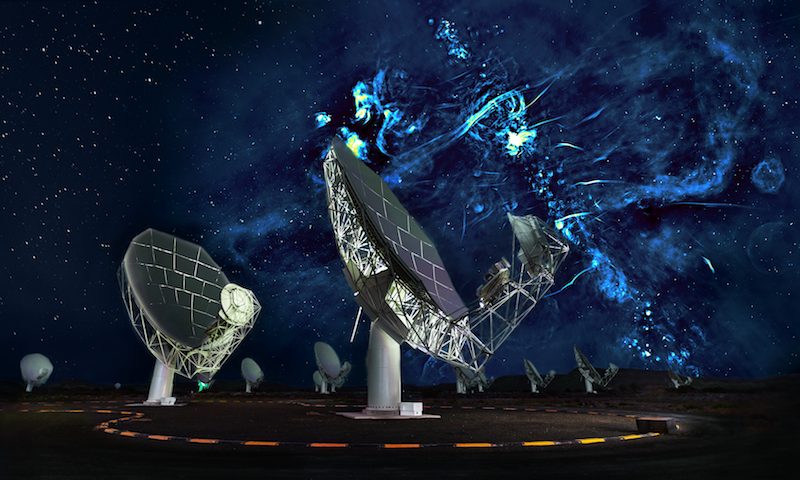

The complex radio emission from the galactic center, as imaged by the South African MeerKAT telescope. The newly-discovered giant radio bubbles are the structures running top to bottom in this image. Image via SARAO/Oxford.
Our Milky Way is considered to be a relatively quiescent galaxy, and yet it’s known to have a 4-million-solar-mass black hole at its heart, which is the source of all sorts of fascinating and dynamic processes. Today – September 11, 2019 – an international team of astronomers announced the discovery of yet another of those processes, which generates what they’re calling “one of the largest features ever observed” in the center of the Milky Way. This feature is a pair of enormous radio-emitting bubbles that tower hundreds of light-years above and below the central region of our galaxy. Some of you might recall the discovery of Fermi Bubbles nine years ago – seen at higher-energy wavelengths of light and extending vastly farther into space – and might wonder how this newly found structure relates. More about that below.
In the meantime, think about this new discovery, published today in the peer-reviewed journal Nature. Like the Fermi Bubbles, scientists describe this new feature as being hourglass-shaped. They said in a statement that it:
… dwarfs all other radio structures in the galactic center [and] is likely the result of a phenomenally energetic burst that erupted near the Milky Way’s supermassive black hole a few million years ago.
In other words, said these scientists, they believe features have formed formed from a violent eruption, presumably emanating from the vicinity of the galactic center and its supermassive black hole, which – over a short period of time – punched through the interstellar medium in opposite directions.

Image via SARAO/Oxford.
The team of astronomers that made the discovery was led by Ian Heywood of the University of Oxford in England. They used the South African Radio Astronomy Observatory (SARAO) MeerKAT telescope to map out broad regions in the center of the galaxy. They conducted their radio observations at wavelengths near 23 centimeters (about 9 inches), which, they said:
… indicates energy generated in a process known as synchrotron radiation, in which free-floating electrons are accelerated as they interact with powerful magnetic fields. This produces a characteristic radio signal that can be used to trace energetic regions in space. The radio light seen by MeerKAT penetrates the dense clouds of dust that block visible light from the center of our galaxy.
Heywood, who processed the large amount of observational data leading to this result, said:
The center of our galaxy is relatively calm when compared to other galaxies with very active central black holes. Even so, the Milky Way’s central black hole can become uncharacteristically active, flaring up as it periodically devours massive clumps of dust and gas. It’s possible that one such feeding frenzy triggered powerful outbursts that inflated this previously unseen feature.
Unseen? Yes, in the radio part of the spectrum. But there’s another structure previously known by astronomers that may (or may not) be related to the discovery announced on September 11, 2019. And that is the so-called Fermi Bubbles, confirmed by high-energy gamma ray observations in 2010.

Hints of the Fermi Bubbles’ edges were first observed in X-rays (blue) by ROSAT, a joint German, U.S. and British X-ray observatory, which operated in space throughout the 1990s. Later, the Fermi Gamma-ray Space Telescope – launched in 2008 – confirmed the outlines of 2 vast bubbles extending for tens of thousands of light-years on either side of our galaxy’s core. Those observations are marked in magenta in this illustration. Image via NASA’s Goddard Space Flight Center.
I asked one of the authors on this new paper – Fernando Camilo, SARAO Chief Scientist in Cape Town, South Africa – how the new discovery relates to the Fermi Bubbles. He replied by email:
That’s a very good question.
The Fermi bubbles are much larger than the MeerKAT radio bubbles (about 50 times larger: some 75,000 light years in size for Fermi, 1,400 light years for MeerKAT). They are also much more energetic: the amount of energy involved in the event that inflated the MeerKAT bubbles is no more than 1% of the energy content of the Fermi bubbles.
However, they are both huge bi-polar structures, symmetric about the galactic center, near the central supermassive black hole, and so your question does arise.
Our view is that the MeerKAT bubbles may well represent a less energetic version of a process similar to that which created the Fermi Bubbles (the origin of the Fermi bubbles themselves continues to be greatly debated, and I expect that the origin of the MeerKAT bubbles will likewise elicit a range of views).
If that’s the case, the MeerKAT bubbles may well be an example of a series of such intermittent events that occasionally take place near the center of the Milky Way, governed by the black hole, the cumulative effect of which is responsible for other large scale structures seen at higher galactic latitudes (that is, away from the plane of the Milky Way), including structures seen in X-rays and, indeed, the Fermi gamma-ray Bubbles.
Camilo added:
These enormous bubbles have until now been hidden by the glare of extremely bright radio emission from the center of the galaxy. Teasing out the bubbles from the background ‘noise’ was a technical tour de force, only made possible by MeerKAT’s unique characteristics and propitious location in the Southern Hemisphere. With this unexpected discovery we’re witnessing in the Milky Way a novel manifestation of galaxy-scale outflows of matter and energy, ultimately governed by the central black hole.

A composite of the radio bubbles and the MeerKAT telescope. A radio image of the center of the Milky Way with a portion of the MeerKAT telescope array in the foreground. The plane of the galaxy is marked by a series of bright features, exploded stars and regions where new stars are being born, and runs diagonally across the image from lower right to top center. The black hole at the center of the Milky Way is hidden in the brightest of these extended regions. The radio bubbles extend from between the two nearest antennas to the upper right corner. Many magnetized filaments can be seen running parallel to the bubbles. In this composite view, the sky to the left of the second nearest antenna is the night sky visible to the unaided eye, and the radio image to the right has been enlarged to highlight its fine features. Image via SARAO/Oxford.
Bottom line: Radio astronomers have spied a pair of enormous radio-emitting bubbles that tower hundreds of light-years above and below the central region of our galaxy.
Source: Inflation of 430-Parsec Bipolar Radio Bubbles in the Galactic Centre by an Energetic Event
from EarthSky https://ift.tt/32DzT6N


The complex radio emission from the galactic center, as imaged by the South African MeerKAT telescope. The newly-discovered giant radio bubbles are the structures running top to bottom in this image. Image via SARAO/Oxford.
Our Milky Way is considered to be a relatively quiescent galaxy, and yet it’s known to have a 4-million-solar-mass black hole at its heart, which is the source of all sorts of fascinating and dynamic processes. Today – September 11, 2019 – an international team of astronomers announced the discovery of yet another of those processes, which generates what they’re calling “one of the largest features ever observed” in the center of the Milky Way. This feature is a pair of enormous radio-emitting bubbles that tower hundreds of light-years above and below the central region of our galaxy. Some of you might recall the discovery of Fermi Bubbles nine years ago – seen at higher-energy wavelengths of light and extending vastly farther into space – and might wonder how this newly found structure relates. More about that below.
In the meantime, think about this new discovery, published today in the peer-reviewed journal Nature. Like the Fermi Bubbles, scientists describe this new feature as being hourglass-shaped. They said in a statement that it:
… dwarfs all other radio structures in the galactic center [and] is likely the result of a phenomenally energetic burst that erupted near the Milky Way’s supermassive black hole a few million years ago.
In other words, said these scientists, they believe features have formed formed from a violent eruption, presumably emanating from the vicinity of the galactic center and its supermassive black hole, which – over a short period of time – punched through the interstellar medium in opposite directions.

Image via SARAO/Oxford.
The team of astronomers that made the discovery was led by Ian Heywood of the University of Oxford in England. They used the South African Radio Astronomy Observatory (SARAO) MeerKAT telescope to map out broad regions in the center of the galaxy. They conducted their radio observations at wavelengths near 23 centimeters (about 9 inches), which, they said:
… indicates energy generated in a process known as synchrotron radiation, in which free-floating electrons are accelerated as they interact with powerful magnetic fields. This produces a characteristic radio signal that can be used to trace energetic regions in space. The radio light seen by MeerKAT penetrates the dense clouds of dust that block visible light from the center of our galaxy.
Heywood, who processed the large amount of observational data leading to this result, said:
The center of our galaxy is relatively calm when compared to other galaxies with very active central black holes. Even so, the Milky Way’s central black hole can become uncharacteristically active, flaring up as it periodically devours massive clumps of dust and gas. It’s possible that one such feeding frenzy triggered powerful outbursts that inflated this previously unseen feature.
Unseen? Yes, in the radio part of the spectrum. But there’s another structure previously known by astronomers that may (or may not) be related to the discovery announced on September 11, 2019. And that is the so-called Fermi Bubbles, confirmed by high-energy gamma ray observations in 2010.

Hints of the Fermi Bubbles’ edges were first observed in X-rays (blue) by ROSAT, a joint German, U.S. and British X-ray observatory, which operated in space throughout the 1990s. Later, the Fermi Gamma-ray Space Telescope – launched in 2008 – confirmed the outlines of 2 vast bubbles extending for tens of thousands of light-years on either side of our galaxy’s core. Those observations are marked in magenta in this illustration. Image via NASA’s Goddard Space Flight Center.
I asked one of the authors on this new paper – Fernando Camilo, SARAO Chief Scientist in Cape Town, South Africa – how the new discovery relates to the Fermi Bubbles. He replied by email:
That’s a very good question.
The Fermi bubbles are much larger than the MeerKAT radio bubbles (about 50 times larger: some 75,000 light years in size for Fermi, 1,400 light years for MeerKAT). They are also much more energetic: the amount of energy involved in the event that inflated the MeerKAT bubbles is no more than 1% of the energy content of the Fermi bubbles.
However, they are both huge bi-polar structures, symmetric about the galactic center, near the central supermassive black hole, and so your question does arise.
Our view is that the MeerKAT bubbles may well represent a less energetic version of a process similar to that which created the Fermi Bubbles (the origin of the Fermi bubbles themselves continues to be greatly debated, and I expect that the origin of the MeerKAT bubbles will likewise elicit a range of views).
If that’s the case, the MeerKAT bubbles may well be an example of a series of such intermittent events that occasionally take place near the center of the Milky Way, governed by the black hole, the cumulative effect of which is responsible for other large scale structures seen at higher galactic latitudes (that is, away from the plane of the Milky Way), including structures seen in X-rays and, indeed, the Fermi gamma-ray Bubbles.
Camilo added:
These enormous bubbles have until now been hidden by the glare of extremely bright radio emission from the center of the galaxy. Teasing out the bubbles from the background ‘noise’ was a technical tour de force, only made possible by MeerKAT’s unique characteristics and propitious location in the Southern Hemisphere. With this unexpected discovery we’re witnessing in the Milky Way a novel manifestation of galaxy-scale outflows of matter and energy, ultimately governed by the central black hole.

A composite of the radio bubbles and the MeerKAT telescope. A radio image of the center of the Milky Way with a portion of the MeerKAT telescope array in the foreground. The plane of the galaxy is marked by a series of bright features, exploded stars and regions where new stars are being born, and runs diagonally across the image from lower right to top center. The black hole at the center of the Milky Way is hidden in the brightest of these extended regions. The radio bubbles extend from between the two nearest antennas to the upper right corner. Many magnetized filaments can be seen running parallel to the bubbles. In this composite view, the sky to the left of the second nearest antenna is the night sky visible to the unaided eye, and the radio image to the right has been enlarged to highlight its fine features. Image via SARAO/Oxford.
Bottom line: Radio astronomers have spied a pair of enormous radio-emitting bubbles that tower hundreds of light-years above and below the central region of our galaxy.
Source: Inflation of 430-Parsec Bipolar Radio Bubbles in the Galactic Centre by an Energetic Event
from EarthSky https://ift.tt/32DzT6N

Aucun commentaire:
Enregistrer un commentaire